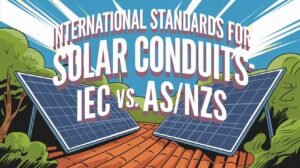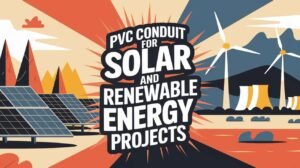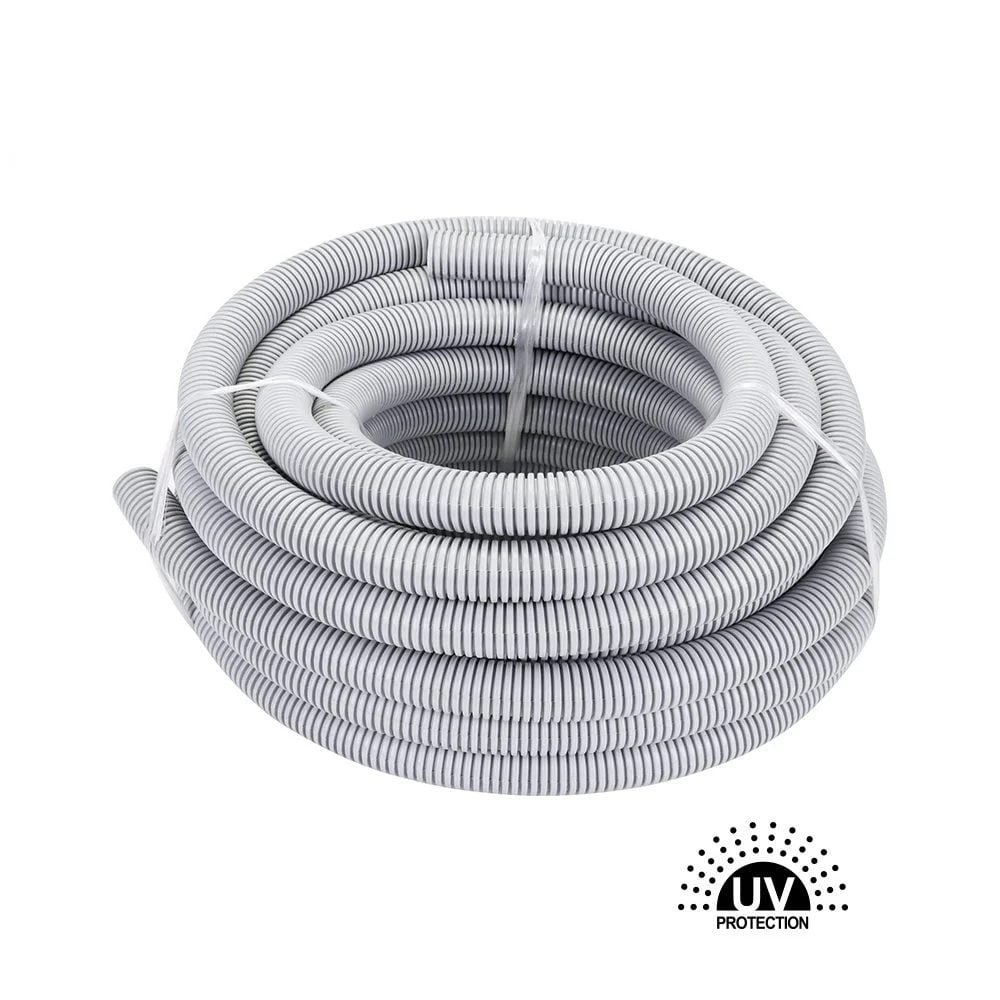Table of Contents
Toggle1. Introduction
Solar panels have become a cornerstone of renewable energy production, offering an environmentally friendly and cost-effective alternative to traditional energy sources like fossil fuels. As the world increasingly shifts towards cleaner, sustainable energy solutions, solar power stands out for its abundance, accessibility, and low environmental impact. Solar panels, which harness energy from the sun, convert sunlight into electricity through photovoltaic cells, making them an essential technology in the global effort to combat climate change.
In addition to their environmental benefits, solar panels have significant economic advantages. With the cost of solar technology continuing to decrease, it has become more affordable for homeowners and businesses to invest in solar power systems. Solar energy can lead to significant savings on utility bills, especially as the price of traditional energy continues to rise. In many regions, governments offer incentives, tax rebates, or subsidies, making solar power even more accessible. Over time, these financial benefits make solar panels a smart, long-term investment.

While solar panels are durable and can last for decades, proper maintenance is essential for ensuring they perform at their best. In fact, regular maintenance is key to maximizing their efficiency, extending their lifespan, and protecting the financial investment made in solar technology. Even the most advanced solar panel systems can experience a drop in performance due to neglect or environmental factors. Whether it’s dirt accumulation, shading from nearby trees, or a decline in system components over time, these issues can reduce the amount of electricity the panels generate.
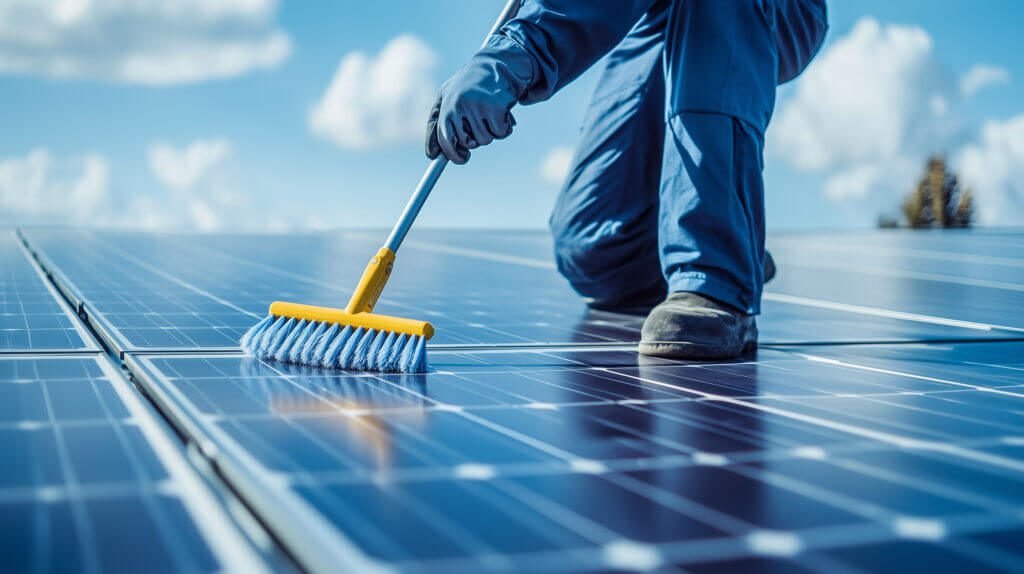
This guide is designed to provide you with comprehensive insights on how to properly clean and maintain your solar panels to ensure optimal performance and efficiency.
2. How Solar Panels Work and Why Cleaning is Essential
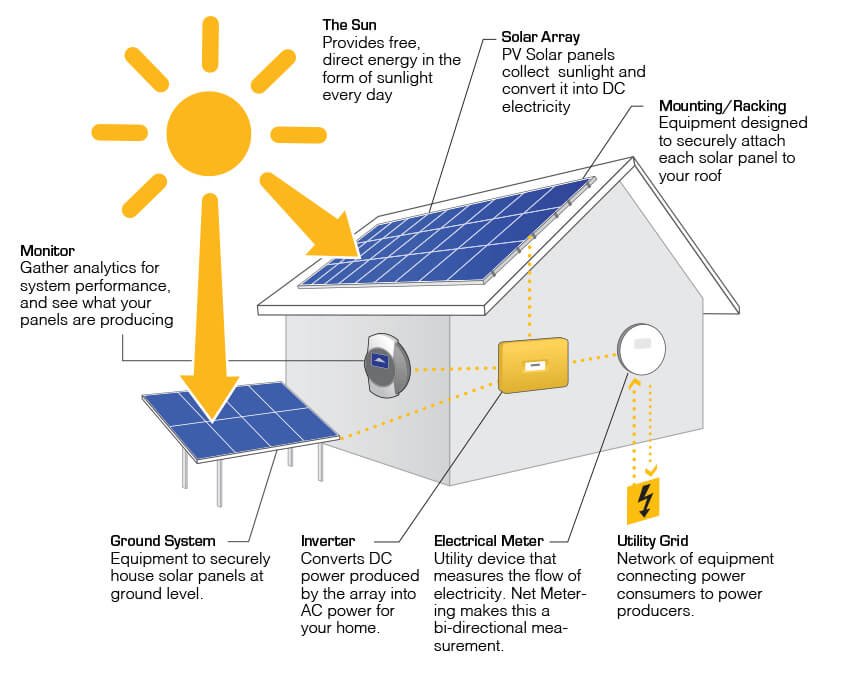
2.1 Understanding Solar Panel Efficiency
Solar panels work by converting sunlight into electricity using the photovoltaic (PV) effect. At the heart of every solar panel are photovoltaic cells, which are made of semiconductor materials—typically silicon. When sunlight hits these cells, it excites the electrons in the material, creating an electric current. This direct current (DC) electricity is then sent through an inverter, which converts it into alternating current (AC) electricity, the form used to power homes and businesses.
The efficiency of a solar panel refers to how well it can convert sunlight into usable electricity. Factors that affect this efficiency include the quality of the photovoltaic cells, the angle of the panels, the amount of sunlight available, and the cleanliness of the panels. Under ideal conditions, modern solar panels can convert 15-22% of the sunlight they receive into electricity, but this efficiency can be reduced if the panels are dirty or obstructed.
Solar panels are designed to work efficiently for many years, typically around 25-30 years, but maintaining their efficiency is key. Even small reductions in efficiency can have a significant impact over time, especially as the energy generated contributes to long-term savings on electricity bills.
2.2 The Impact of Dirt and Dust Accumulation on Panel Performance

Soiling—the accumulation of dirt, dust, bird droppings, and other debris—can have a significant negative effect on the efficiency of solar panels. Several studies, including research from the National Renewable Energy Laboratory (NREL), have highlighted the potential energy loss due to soiling. This loss may seem small, but over the lifespan of a solar panel system, it can lead to substantial reductions in overall energy generation and financial savings.
For example, in areas where dust storms are common, like deserts or arid regions, soiling can cause solar panels to lose a significant amount of their potential output. In these environments, dust accumulation can reduce efficiency by 10–30% depending on the intensity of the dust buildup. Even relatively minor amounts of dirt on the panels can decrease their efficiency by 5–7%, which can be enough to reduce energy savings by hundreds of dollars annually, especially in large-scale solar installations.

2.3 Studies and Data on Soiling Losses: Dusty Environments
Research conducted by the National Renewable Energy Laboratory (NREL) and other solar energy organizations has quantified the impact of soiling on solar panel performance. In one study, NREL found that solar panel efficiency could drop by as much as 7% in some dusty environments after just a few months of neglect. In extremely dusty regions, the loss could be even more severe.
In regions like the Middle East, Southwest United States, or parts of Australia, where dust storms or frequent dry conditions prevail, solar panels can become heavily covered with fine dust particles. This dust not only blocks sunlight but also contributes to the formation of a thin, stubborn layer that can be difficult to remove without proper cleaning methods. In these environments, daily dust accumulation can cause substantial energy production losses if not addressed regularly.

For example:
- In the Middle East and North Africa, where dust storms are frequent, soiling losses can reach up to 20–30% of energy production if panels are left uncleaned for extended periods.
- In California’s Central Valley, a region with high dust levels, cleaning solar panels every 3–6 months can reduce energy losses by as much as 10–15%.
- In India, where air pollution is a growing concern, studies have shown that pollution-induced soiling can reduce panel efficiency by 7% annually.
The NREL study also noted that soiling impacts vary depending on the type of dust or pollutants that accumulate on the panels. Finer particles, such as dust or sand, have a more significant effect because they create a dense layer that is harder to remove and blocks more sunlight compared to coarser debris.
2.4 Other Scenarios and Their Effects

Bird Droppings and Organic Debris: Bird droppings, leaves, and other organic materials can also hinder the ability of solar panels to absorb sunlight. Bird droppings, in particular, are acidic and can degrade the panel’s surface if left untreated. Over time, this can cause permanent damage to the panel’s protective coating, leading to decreased performance and higher maintenance costs.
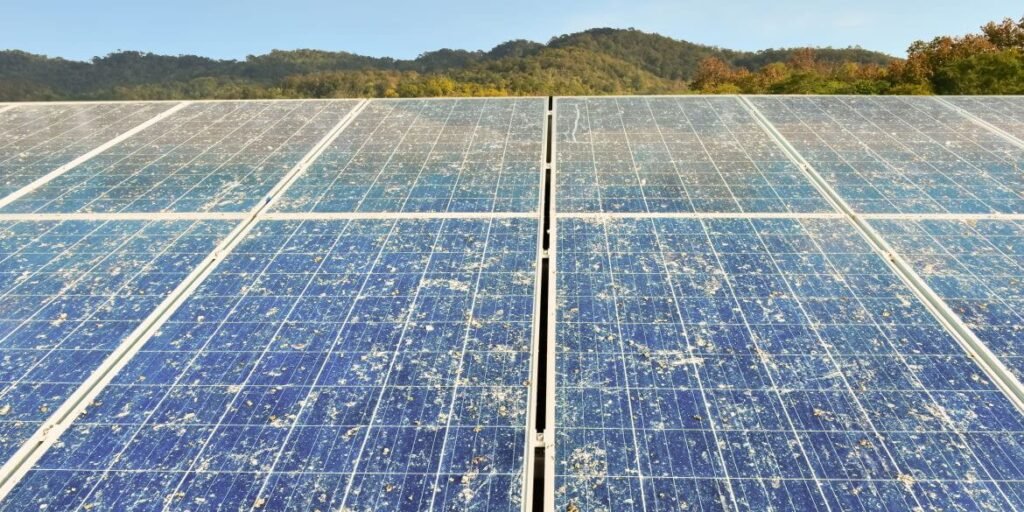
Pollution: In urban areas with high levels of industrial pollution or smog, solar panels are often exposed to pollutants like soot, ash, and other particulate matter. Over time, these pollutants can create a film on the surface of the panels, diminishing their ability to absorb sunlight. For example, in highly polluted regions such as New Delhi, Beijing, or Los Angeles, pollutants can reduce solar panel efficiency by 5–10% annually if cleaning is infrequent.

Pollen Accumulation: While pollen accumulation typically doesn’t pose the same risk as dust or pollution, it can still block sunlight and reduce efficiency, particularly in spring and early summer. In areas with dense vegetation, pollen can coat the surface of solar panels, especially during flowering seasons. While the effect of pollen is usually less dramatic compared to dust, in areas with high pollen counts (such as parts of the Southeast United States or Europe), it can still lead to minor drops in panel performance.
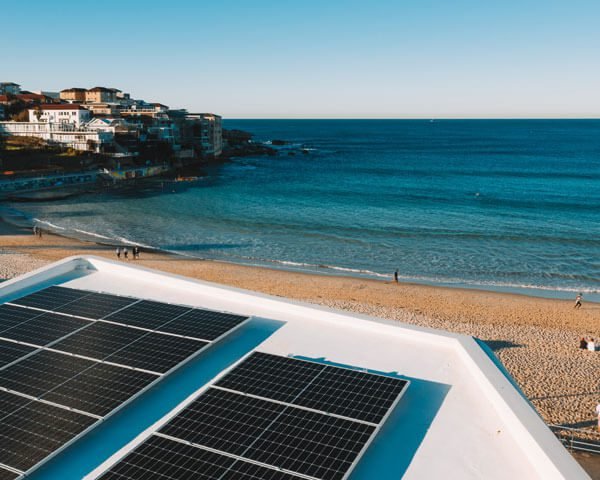
Coastal Regions (Salt Accumulation):In coastal areas, salt from the sea air can accumulate on solar panels, leading to corrosion and reduced efficiency. This is especially a concern for panels installed on roofs near the coastline, where saltwater exposure can create layers of salt on the panel surface. The salt not only blocks sunlight but can also cause long-term degradation of the panel’s protective coatings if not cleaned off regularly.
3. Cleaning Your Solar Panels: Step-by-Step Guide
3.1 Safety First: Precautions Before Cleaning
Before you begin cleaning your solar panels, it’s important to follow the proper safety measures to protect yourself and your equipment. Solar panels are often installed on rooftops or in hard-to-reach places, so safety precautions are essential.
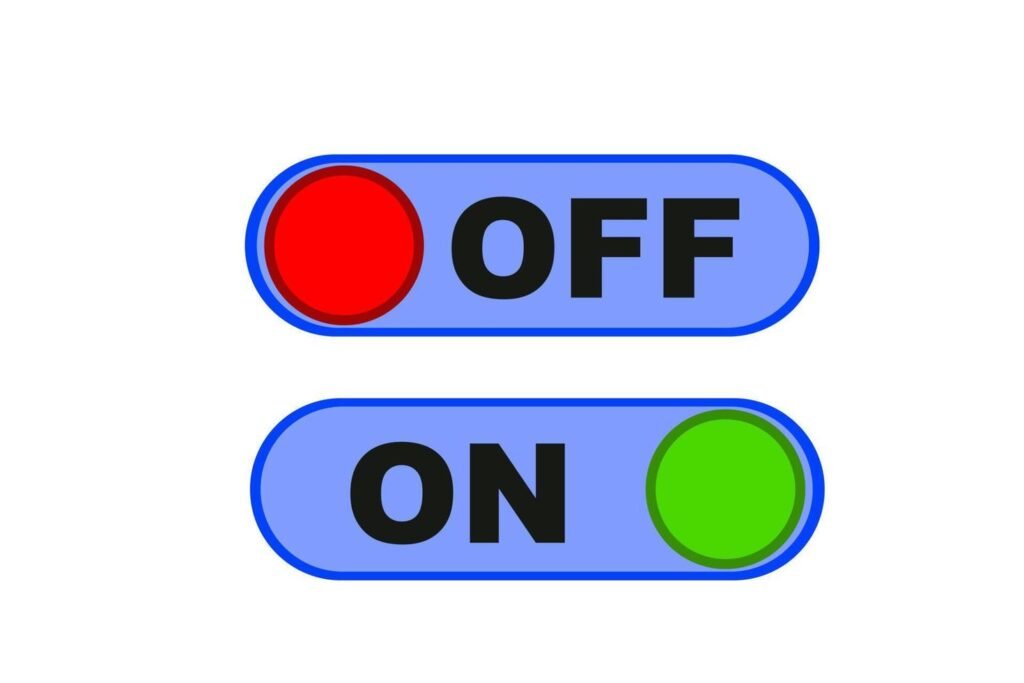
3.1.1 Turn Off the Solar Panel System
Solar panels generate electricity, and while the risk of electrical shock is low under normal conditions, it’s always best to be cautious. Turn off the solar panel system before you begin cleaning. Most systems have a shutdown procedure that involves turning off the inverter or flipping the circuit breakers in your electrical panel. This ensures that the system is not generating or transmitting electrical current while you’re cleaning, protecting you from any accidental shocks.
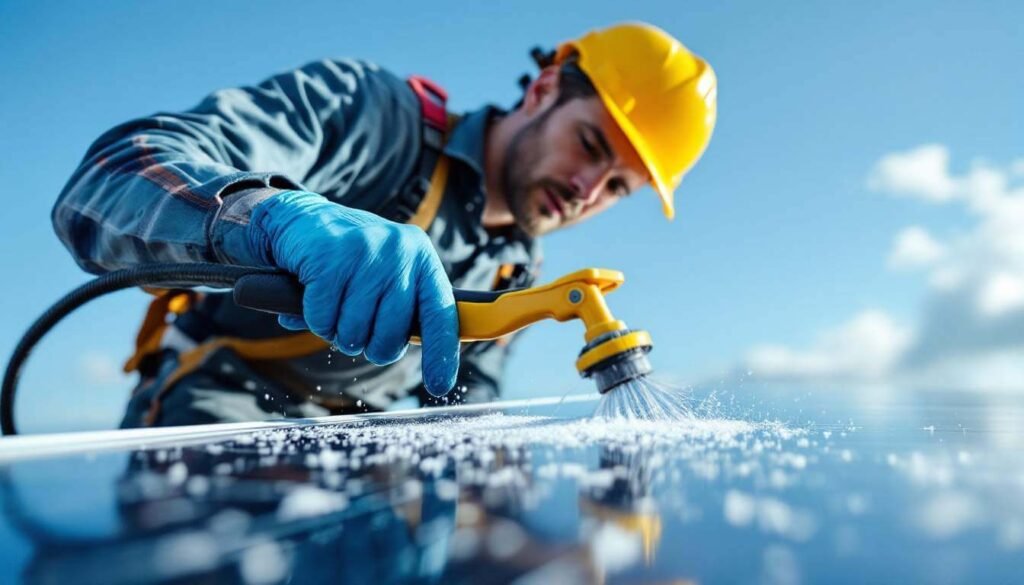
3.1.2 Use the Right Tools
Ladder: If your solar panels are on a rooftop, use a sturdy, secure ladder to reach them. Ensure the ladder is on level ground to prevent accidents. If the roof is steep or high, consider using a roof harness or safety ropes for added security.
Gloves: Wearing gloves is crucial to protect your hands from sharp edges or dirt, and to prevent oils from your skin from transferring to the panel surface.
Non-Slip Footwear: Wear non-slip shoes to maintain good traction, especially when working on wet or uneven surfaces.
Be Cautious When Accessing Rooftops
If you’re cleaning panels on a roof, take extra care when climbing or walking on the roof. Wet or slippery conditions, uneven tiles, or steep angles can be hazardous. If you’re not comfortable working on a rooftop, or if your roof is steep or too high, it’s safer to hire a professional solar cleaning service.

3.1.3 Cleaning Equipment Needed
Having the right cleaning equipment is essential to avoid damage to your solar panels. Here are the tools you’ll need to clean your panels safely and effectively:
- Soft Brushes: Use a soft-bristled brush to remove loose dirt, dust, and debris from the panel surface. A brush with gentle bristles will help you avoid scratching or damaging the surface of the panels. Avoid using hard brushes, scrubbers, or abrasive tools that could scratch the glass.
- Microfiber Cloths: Microfiber cloths are ideal for drying the panels after cleaning. These cloths are soft, lint-free, and absorbent, making them perfect for wiping off excess water without leaving streaks or damage. Microfiber also helps prevent scratching the surface.
- Squeegee: A squeegee is another essential tool to help remove water and avoid streaks after rinsing. It ensures that water drains off the panels evenly, leaving them clean and dry without residue.
- Garden Hose: A garden hose with a gentle spray nozzle is ideal for rinsing the panels after cleaning. It provides enough pressure to wash away dirt without damaging the panels. Make sure to use low pressure, as high-pressure water from a pressure washer can cause the panels to shift or even break.
- Mild Dish Soap: For cleaning, use mild dish soap. Avoid harsh chemicals, bleach, or abrasive cleaners, as these can damage the surface of the panels and reduce their efficiency. A small amount of soap mixed with lukewarm water is all you need for effective cleaning.
- Lukewarm Water: Always use lukewarm or cool water when cleaning solar panels. Hot water can cause thermal shock, especially if the panels are hot from sunlight. Lukewarm water ensures that the panels are cleaned effectively without risking damage.
3.2 Step-by-Step Process
Now that you have the necessary tools and safety measures in place, let’s walk through the cleaning process step by step.

3.2.1 Remove Loose Debris
Before applying any water or cleaning solution, remove any loose debris from the panels. This includes leaves, sticks, or large clumps of dirt that could scratch the surface if scrubbed. Use a soft brush to gently sweep off debris. Always work gently to avoid scratching the panel’s glass or damaging the surrounding frame.
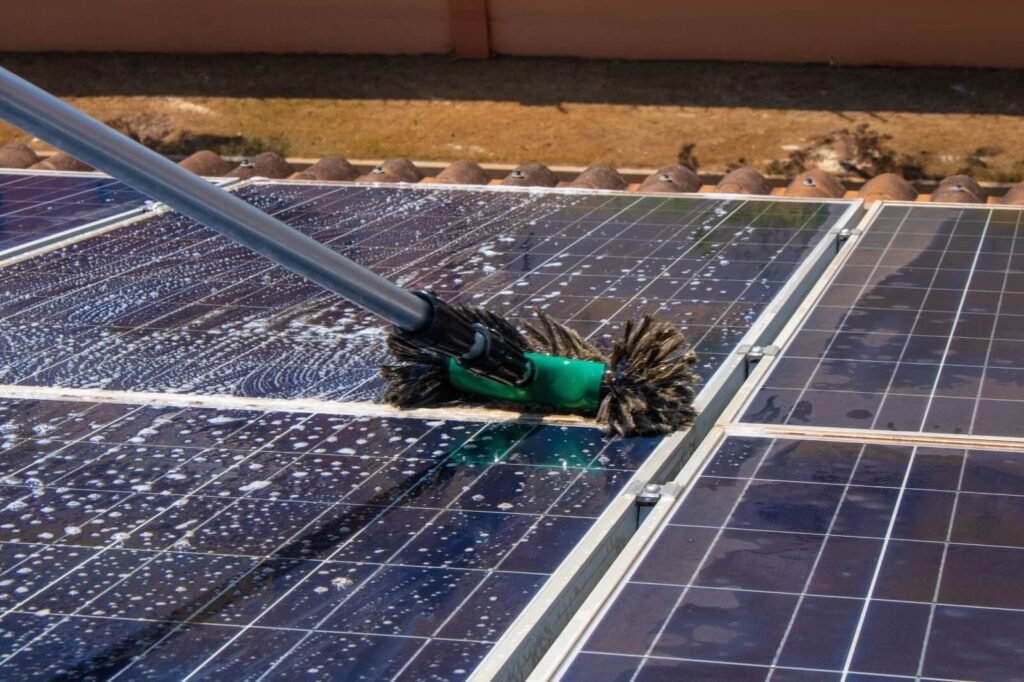
3.2.2 Clean with Soapy Water
Prepare a bucket of lukewarm water with a small amount of mild dish soap. Wet a soft sponge or cloth with the soapy water and gently wipe down the surface of each panel. Be sure to clean the panels from top to bottom, so that dirty water flows down and doesn’t drip onto areas you’ve already cleaned. For tougher spots (like bird droppings), let the soapy water sit for a minute or two to loosen the dirt before gently scrubbing it off.
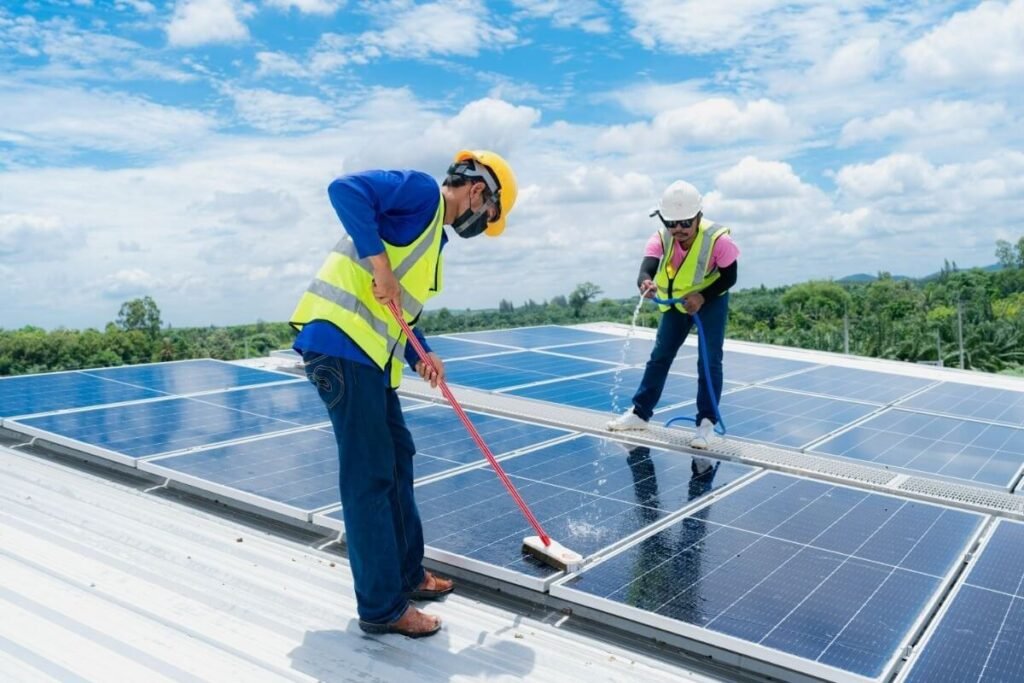
3.2.3 Rinse Gently with a Garden Hose
Once the panels are cleaned with soap, it’s time to rinse them off. Use a garden hose with a low-pressure nozzle to rinse the panels gently. Start from the top and work your way down, allowing water to flow over the panels and carry away any remaining soap or debris. Do not use a pressure washer, as it can be too forceful and could damage the panels or their seals.

3.2.4 Dry with a Microfiber Cloth or Squeegee
After rinsing, use a microfiber cloth to gently dry the panels and remove any water spots. Alternatively, you can use a squeegee to remove excess water from the surface of the panels. Be sure to dry the panels completely to avoid streaks and water spots, which could affect sunlight absorption.
3.2.5 Check Energy Output After Cleaning
After cleaning, it’s a good idea to monitor the system’s energy output to ensure that the panels are working efficiently. Check the readings from your solar inverter or use your solar monitoring system (if available) to see if there is an increase in energy production. Cleaning your panels should result in improved efficiency and higher energy output.
4. How Often Should You Clean Solar Panels?
In this section, we’ll dive into the key factors that affect how often you should clean your solar panels, and provide guidance on when cleaning is necessary based on those factors.
4.1 Factors Affecting Cleaning Frequency
Several environmental and geographic factors influence how often your solar panels should be cleaned. Understanding these factors will help you develop a maintenance schedule that suits your specific needs.

4.1.1 Weather
The weather plays a significant role in the amount of dirt and debris that accumulates on your solar panels. Different weather conditions can either reduce or increase the frequency of cleaning required:

- Rain: One of the benefits of rain is that it can naturally wash off dust, dirt, and debris from your solar panels. In areas where rain is frequent, you may find that your panels stay clean without much effort on your part. However, if there is prolonged dry weather between rainfalls, dirt may still build up.
- Snow: In colder climates, snow can accumulate on your panels and reduce their efficiency. While snow itself is not particularly dirty, it does block sunlight, preventing the panels from generating power. You may need to clear off snow or wait for it to melt naturally (if temperatures allow) to restore efficiency.
- Dust Storms: In areas prone to dust storms, like deserts, dirt and sand can build up on the panels quickly. In such environments, cleaning may be required more frequently, especially after storms, to maintain the panel’s energy production.
4.1.2 Geographic Location
The location of your solar panels is one of the most important factors in determining cleaning frequency. Certain areas are more prone to pollution, dust, and other environmental pollutants that can accumulate on solar panels. Some scenarios to consider include:

- Dry, Dusty Areas: In places with little rain and frequent dust or pollen, such as arid climates, you’ll need to clean your solar panels more often. Dust can accumulate quickly and block sunlight, reducing the system’s efficiency.
- Urban Areas: Cities and industrial areas often have higher pollution levels, which can result in grime and soot building up on solar panels. Areas near highways or factories, for instance, may have significant pollution that impacts panel performance. If you live in such an area, it’s important to clean your panels more regularly to avoid energy loss.

- Coastal Areas: Coastal environments can cause salt to accumulate on solar panels due to the salty air. Salt can corrode panel components over time, leading to damage. Coastal areas may require more frequent cleaning to remove salt buildup and protect the panels.
4.1.3 Nearby Vegetation
If your solar panels are installed near trees or other vegetation, you might need to clean them more frequently. Falling leaves, pollen, and branches can block sunlight or leave sticky residues on the surface. During certain times of the year, like spring and fall, cleaning may be necessary to remove organic debris that can hinder panel performance.
4.2 Cleaning Intervals
Given the various factors that affect dirt accumulation, it’s helpful to have a general guideline for cleaning your solar panels. Here’s a recommended cleaning schedule based on environmental conditions:
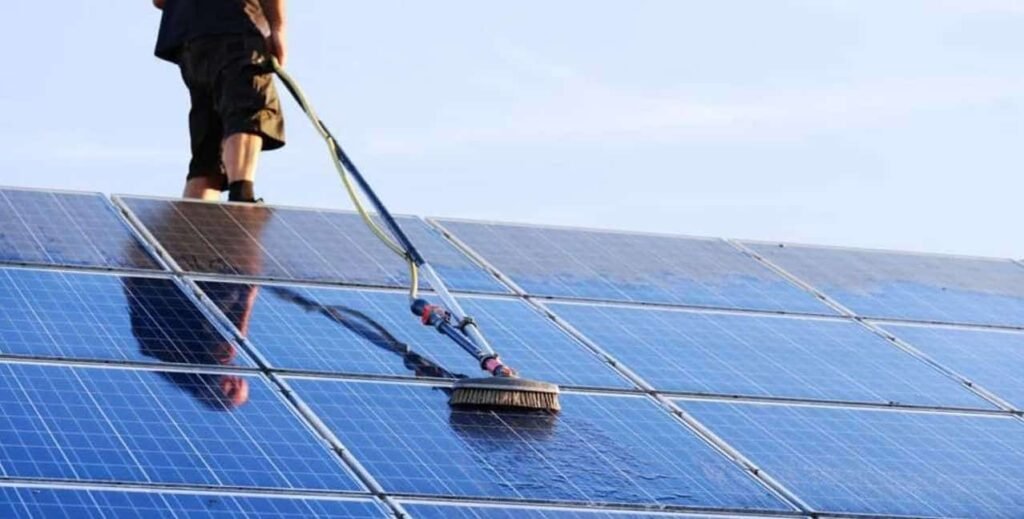
4.2.1 General Recommendation: Clean Every 6 Months
For most homeowners, cleaning their solar panels about every 6 months is usually sufficient. This interval works well in areas that have moderate weather conditions, with occasional rain to naturally wash away debris. A semi-annual cleaning ensures that dirt, dust, and other contaminants don’t build up to the point where they significantly impact energy production.
4.2.2 More Frequent Cleaning in Areas with High Pollution or Dust Accumulation
If you live in an area with high levels of dust, pollution, or heavy pollen accumulation, you may need to clean your panels more frequently. In dry or desert regions, where dust storms are common, cleaning every 3 to 4 months may be necessary. Likewise, in urban or industrial areas with pollution, it’s a good idea to clean the panels every 4 to 6 months to prevent the buildup of soot, grime, and other pollutants.
4.2.3 Less Frequent Cleaning in Wet or Rain-Prone Areas
If you live in an area that experiences frequent rainfall, your solar panels may not require cleaning as often. The rain can help keep the panels free of dirt and debris, reducing the need for regular intervention. In such cases, you might only need to clean the panels once a year or every 12 months, depending on the amount of dirt buildup and other factors like tree coverage.
4.3 Signs Your Solar Panels Need Cleaning
Even if you don’t follow a strict cleaning schedule, there are clear signs that indicate it’s time to clean your solar panels. These signs can help you determine when to take action and ensure that your panels are functioning at peak performance.
- Visible Dirt or Debris
If you can clearly see dirt, dust, bird droppings, or other debris on the surface of your panels, it’s time to clean them. Accumulation of dirt is one of the most obvious signs that the panels are no longer operating at optimal efficiency. Regularly inspect the panels for visible buildup to determine when cleaning is necessary. - Bird Droppings
Bird droppings are particularly problematic because they not only obstruct sunlight but can also leave stubborn stains if not cleaned off promptly. The acidity in bird droppings can cause damage to the panel surface if left untreated for long periods. If you notice bird droppings on your panels, clean them as soon as possible to avoid potential damage. - Noticed Drop in Energy Output
A noticeable drop in energy output is a key indicator that your solar panels may need cleaning. If your system’s energy production has declined, even though weather conditions and sunlight availability haven’t changed, dirt accumulation could be the cause. Use your solar monitoring system or check the inverter’s display to see if energy production has decreased. If so, cleaning the panels may help restore optimal performance. - Lack of Rainfall
In dry climates where it doesn’t rain often, dust and dirt can accumulate quickly. If you haven’t had significant rainfall in weeks or months, and the panels appear dusty or dirty, it’s time to clean them. You can often tell when it’s time to clean based on how much dirt has built up since the last rain.
5. DIY vs. Professional Solar Panel Cleaning

When it comes to cleaning your solar panels, you have two main options: doing it yourself (DIY) or hiring a professional cleaning service. Both methods have their pros and cons, and the best choice depends on factors such as the type of solar installation, your comfort with heights, and the tools you have available. This section will help you weigh the benefits of each option and guide you on when it’s best to tackle the cleaning yourself or call in the experts.
5.1 When to DIY: Cleaning Solar Panels Yourself
In many cases, homeowners can clean their solar panels themselves. DIY cleaning is an effective and low-cost option, provided that the panels are easily accessible and you have the right tools. Here are the situations where DIY cleaning is a good choice:
Ground-Mounted Panels or Accessible Roofs
If your solar panels are ground-mounted, cleaning is much easier and safer to do yourself. Ground-mounted panels are often installed at a convenient height, making them easy to access without the need for a ladder or any safety harnesses. Similarly, if you have a low or easily accessible roof, cleaning the panels can be a relatively straightforward task. Just ensure the roof is safe to walk on and that you take appropriate precautions to avoid slipping.

5.2 When to Hire a Professional: Reasons for Professional Cleaning Services
While DIY cleaning can save you money and time, there are certain situations where it is safer, more effective, and more convenient to hire a professional solar panel cleaning service. Here’s when you should consider leaving the job to the experts:
Safety Concerns
Rooftop systems can be dangerous to clean if you’re not comfortable working at heights or if the roof is steep or slippery. Even if you’re confident in your abilities, cleaning solar panels on a high roof involves risks, such as falling or injuring yourself. If you have safety concerns, it’s best to hire a professional who has the proper training and equipment to clean panels safely.
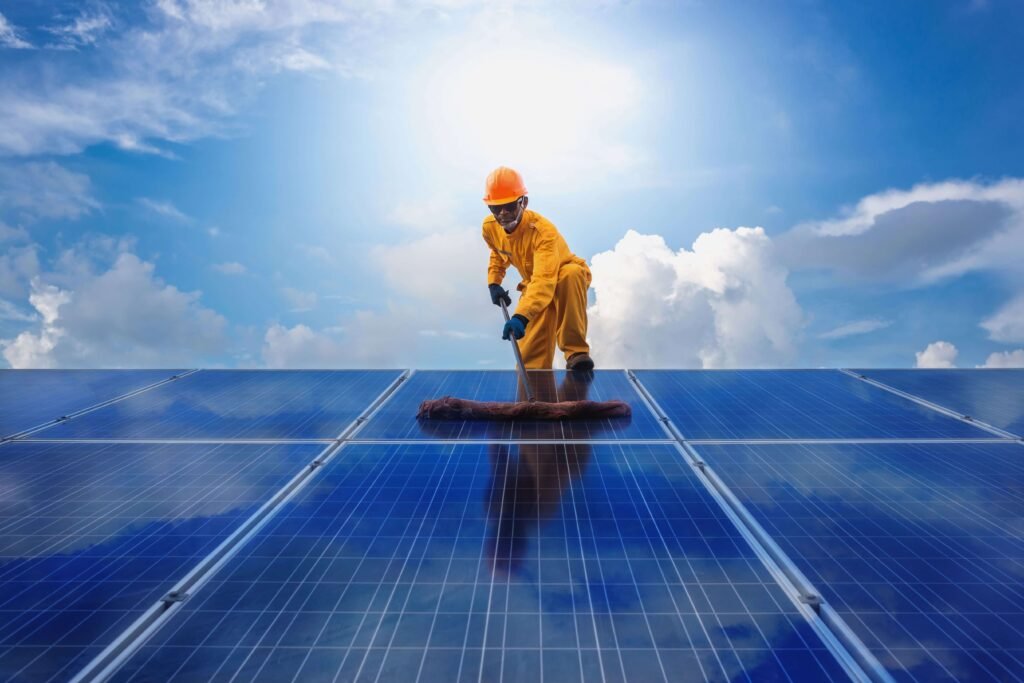
Lack of Time or Tools
Cleaning solar panels requires time and effort. If you’re busy or don’t have access to the necessary cleaning equipment (such as a ladder, soft brushes, or a garden hose), hiring a professional service is a more convenient option. A professional solar cleaning service will have all the necessary tools, and they can complete the job quickly and efficiently.
Hard-to-Reach or Complex Installations
If your solar panels are installed in a hard-to-reach location—for example, a roof with a steep pitch or panels installed on an unusually high building—professional cleaners are better equipped to handle these types of situations. They’ll use specialized equipment like harnesses or scaffolding to ensure that the cleaning is done safely and thoroughly.
Cost of Professional Cleaning Services
Professional solar panel cleaning typically costs between $150 and $300 per service, depending on factors like the size of your system, location, and the complexity of the job. While this is a higher upfront cost than DIY, it may be worth the investment, especially if the panels are difficult to access, or you lack the time and tools to do the job yourself.
5.3 Types of Professional Cleaning Services
Professional solar cleaning services use a variety of methods and tools to clean panels effectively and efficiently. Depending on the service provider and your specific needs, here are some of the common types of professional cleaning methods:

Robotic and Automated Cleaning Methods
Some advanced solar cleaning services use robotic cleaners or automated systems to clean solar panels. These robots are designed to move along the surface of the panels and remove dirt and debris without the need for human labor. Robotic cleaning is ideal for large-scale solar farms or commercial systems, where a faster, more efficient cleaning method is needed. It’s also less likely to cause damage, as the robots are programmed to apply gentle pressure.

Soapless Brushes and Eco-Friendly Cleaning
Eco-conscious professionals often use soapless brushes or eco-friendly cleaning methods to clean solar panels. These brushes use water or specialized cleaning solutions that don’t require soap, which can be more environmentally friendly and reduce the impact on nearby soil or plants. Some services may also use deionized water, which helps prevent streaks or water spots on the panels.
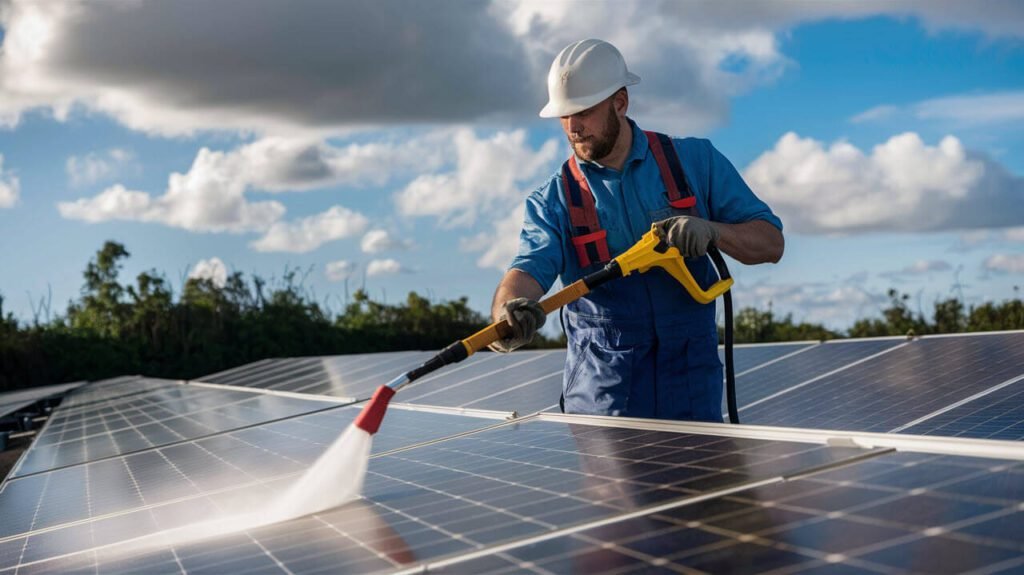
Low-Pressure Water Systems
Professional solar panel cleaning services also use low-pressure water systems to rinse the panels. These systems are designed to clean effectively without causing damage. Since high-pressure washers can sometimes be too harsh, professional services ensure that the right amount of water pressure is used to rinse dirt and debris off without damaging the panels.
6. Additional Considerations for Solar Panel System Performance
In addition to regular cleaning, panel alignment, wiring connections, and inverter health are also critical factors that influence how well your solar system operates. Monitoring these aspects of the system can help you identify potential issues early, allowing for timely intervention and avoiding more costly repairs down the road. A well-maintained solar power system can continue to perform at optimal levels for 25 years or more, producing the most energy possible while minimizing maintenance costs.
6.1 Panel Alignment and Wiring Connections
Proper panel alignment ensures that your solar panels are receiving the maximum amount of sunlight throughout the day. Over time, shifting panels or incorrect installation can lead to reduced energy production. Regular inspections and monitoring can ensure your panels remain correctly oriented to optimize energy capture.
Wiring connections are also crucial for optimal system performance. Loose or damaged wiring can cause energy losses, system failure, or even safety hazards. A periodic inspection of wiring can help identify wear and tear, ensuring that your solar system runs smoothly without interruptions.

6.2 Inverter Health
The inverter is the heart of your solar power system, converting DC power generated by the panels into usable AC power. A malfunctioning or aging inverter can significantly reduce the overall system performance. Ensuring that the inverter is functioning properly and monitoring its output is essential for maintaining efficiency.
6.3 Conduit Usage in Solar Installations
While the performance of solar panels and inverters is critical, the conduits that house your system’s wiring play an equally important role in protecting these components from environmental factors. Conduits protect electrical wiring from physical damage, moisture, and exposure to the elements, ensuring the safe and reliable operation of the system.

Conduits must be carefully selected based on the installation environment and climate. For outdoor or rooftop installations, using durable, UV-resistant PVC conduit helps protect against the elements, such as sunlight, rain, and extreme temperatures, which could otherwise degrade wiring insulation and lead to system failure. Similarly, when installing underground systems, selecting a conduit with high impact resistance and corrosion protection ensures that the wiring remains intact and the system continues to function safely and efficiently.
6.4 Introducing Ctube: Your Partner for High-Quality Conduit Solutions
At Ctube, we specialize in manufacturing high-quality PVC conduits and fittings specifically designed for solar power systems. Our conduits offer superior protection for solar panel wiring, ensuring that your electrical components are shielded from external factors that could affect performance. Whether you’re looking to install your system in dry, dusty areas, or in regions with extreme weather conditions, Ctube’s conduit solutions are designed to offer long-lasting protection and support for your solar power infrastructure.
Ctube’s UV-resistant solar conduit is especially ideal for outdoor solar installations, providing a durable solution that resists degradation from constant sun exposure. Our conduits also meet the highest quality and safety standards, ensuring that your solar system remains safe and reliable for years to come. Whether you need a single length of conduit or a full range of fittings for your solar installation, Ctube can provide tailored solutions to meet your needs.
7. Conclusion
Keeping your solar panels clean is an essential part of maintaining your system’s efficiency, extending its lifespan, and maximizing your energy savings. Regular cleaning—whether DIY or through professional services—will ensure that your panels continue to perform at their best. By understanding the factors that influence cleaning frequency, taking the right safety precautions, and following best maintenance practices, you can ensure your solar investment stays efficient for years to come.
Whether you choose to handle the cleaning yourself or bring in the professionals, the most important thing is to stay proactive about your solar panel maintenance. With the right approach, you’ll get the most out of your system and enjoy the benefits of clean, renewable energy for years to come.
FAQs
1. How Much Does Professional Cleaning Cost?
The cost of professional solar panel cleaning typically ranges from $150 to $300, depending on factors such as the size of your system, your location, and the difficulty of the job. Some companies charge a flat rate for basic cleaning, while others may charge by the number of panels or the time required for the cleaning. It’s a good idea to get a quote from a few providers before committing to a service. Professional cleaners use specialized equipment and techniques to ensure that your panels are cleaned thoroughly and safely, especially for hard-to-reach rooftop systems.
2. Does Cleaning Solar Panels Improve Efficiency?
Yes, cleaning solar panels can significantly improve their efficiency. Over time, dirt, dust, bird droppings, and other debris accumulate on the surface of the panels, blocking sunlight from reaching the photovoltaic cells. This reduces the amount of energy they can generate. Cleaning your panels helps restore their ability to absorb sunlight, leading to higher energy output and more financial savings. In fact, dirty panels can reduce energy production by up to 7% or more, depending on the level of soiling and environmental factors.
3. Can I Use a Pressure Washer on Solar Panels?
No, using a pressure washer on solar panels is harmful and not recommended. The high pressure can easily damage the panels, dislodge the wiring, and potentially create leaks or cracks in the glass. Additionally, pressure washing can push water into sensitive electrical components, increasing the risk of short circuits or system malfunctions. Instead, use a low-pressure hose and a soft brush to clean the panels safely. This approach is gentle enough to clean effectively without causing any damage to the panels.



